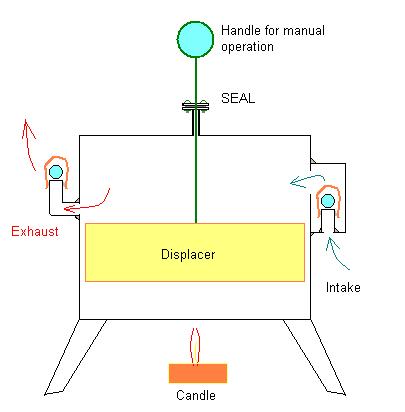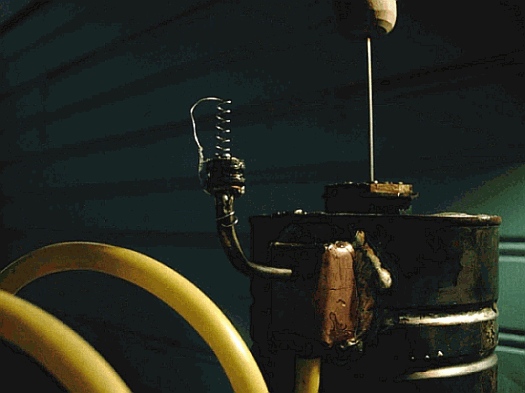Hi,
Several years ago I accidentally, while trying to devise a more efficient Stirling Engine (heat engine) stumbled upon a design that appeared, as far as I could figure - running the engine in my head - to maintain a "cold hole" or sink so as to create a temperature differential between the sink and the solar heat trapped in the air, to run the engine.
The basic concept is to combine a Stirling type displacer / heat-pump unit with an air-cycle cooling system. The result is a relatively simple low-tech device with few moving parts that uses air as a medium throughout the entire system.
What I found particularly interesting is that Tesla described the theory behind just such an engine in some detail in one of his articles and for some time actually worked on building such an engine until his workshop burned down. He apparently never finished building his engine but it also seems he never abandoned the idea. In other words, he believed it to be a real possibility.
As far as I know, nobody knows exactly what Tesla's prototype, if he ever finished it, would have consisted of. So I cannot say that this is THE SAME engine, but the basic operating principle is identical to what Tesla described IN THEORY in his article, that is, an engine that takes in heat from the air to generate power by maintaining a "cold hole". i.e. it takes less energy to throw off the "waste" heat as some of the heat is being converted into another form of energy so that little heat ever actually reaches the sink. The energy thus converted, however great or little, is clear gain.
A Stirling Engine type displacer unit can be modified so as to work like a hydraulic air compressor. The compressed air can be channeled through an air-cycle heat pump which produces very high and very low temperatures. The heat-pump heat exchangers can then be channeled through the displacer chamber which would probably be best made of some kind of ceramic to ensure that the heat flows through the air inside the chamber rather than through the walls of a metal cylinder.
This should be relatively cheap and easy to build. The only way to find out if it will work. I cannot figure out any reason why it shouldn't work.
If anyone is interested I have posted more information / diagrams and animated images on other forums over the years as well as some videos of one of the components I managed to build: A very crude "tin-can" Stirling-Air-Pump,... but it worked!
This is more of a concept drawing rather than what the engine might actually look like:

Several years ago I accidentally, while trying to devise a more efficient Stirling Engine (heat engine) stumbled upon a design that appeared, as far as I could figure - running the engine in my head - to maintain a "cold hole" or sink so as to create a temperature differential between the sink and the solar heat trapped in the air, to run the engine.
The basic concept is to combine a Stirling type displacer / heat-pump unit with an air-cycle cooling system. The result is a relatively simple low-tech device with few moving parts that uses air as a medium throughout the entire system.
What I found particularly interesting is that Tesla described the theory behind just such an engine in some detail in one of his articles and for some time actually worked on building such an engine until his workshop burned down. He apparently never finished building his engine but it also seems he never abandoned the idea. In other words, he believed it to be a real possibility.
As far as I know, nobody knows exactly what Tesla's prototype, if he ever finished it, would have consisted of. So I cannot say that this is THE SAME engine, but the basic operating principle is identical to what Tesla described IN THEORY in his article, that is, an engine that takes in heat from the air to generate power by maintaining a "cold hole". i.e. it takes less energy to throw off the "waste" heat as some of the heat is being converted into another form of energy so that little heat ever actually reaches the sink. The energy thus converted, however great or little, is clear gain.
A Stirling Engine type displacer unit can be modified so as to work like a hydraulic air compressor. The compressed air can be channeled through an air-cycle heat pump which produces very high and very low temperatures. The heat-pump heat exchangers can then be channeled through the displacer chamber which would probably be best made of some kind of ceramic to ensure that the heat flows through the air inside the chamber rather than through the walls of a metal cylinder.
This should be relatively cheap and easy to build. The only way to find out if it will work. I cannot figure out any reason why it shouldn't work.
If anyone is interested I have posted more information / diagrams and animated images on other forums over the years as well as some videos of one of the components I managed to build: A very crude "tin-can" Stirling-Air-Pump,... but it worked!
This is more of a concept drawing rather than what the engine might actually look like:




